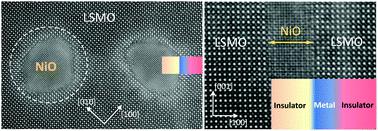当前位置:
X-MOL 学术
›
Mater. Horiz.
›
论文详情
Our official English website, www.x-mol.net, welcomes your feedback! (Note: you will need to create a separate account there.)
Unusual electrical conductivity driven by localized stoichiometry modification at vertical epitaxial interfaces
Materials Horizons ( IF 13.3 ) Pub Date : 2020-09-24 , DOI: 10.1039/d0mh01324b Wenrui Zhang 1, 2, 3, 4, 5 , Shaobo Cheng 4, 6, 7, 8 , Christopher M. Rouleau 2, 3, 4, 5 , Kyle P. Kelley 2, 3, 4, 5 , Jong Keum 2, 3, 4, 5, 9 , Eli Stavitski 4, 7, 8, 10 , Yimei Zhu 4, 6, 7, 8 , Matthew F. Chisholm 2, 3, 4, 5 , Zheng Gai 2, 3, 4, 5 , Gyula Eres 1, 2, 3, 4, 5
Materials Horizons ( IF 13.3 ) Pub Date : 2020-09-24 , DOI: 10.1039/d0mh01324b Wenrui Zhang 1, 2, 3, 4, 5 , Shaobo Cheng 4, 6, 7, 8 , Christopher M. Rouleau 2, 3, 4, 5 , Kyle P. Kelley 2, 3, 4, 5 , Jong Keum 2, 3, 4, 5, 9 , Eli Stavitski 4, 7, 8, 10 , Yimei Zhu 4, 6, 7, 8 , Matthew F. Chisholm 2, 3, 4, 5 , Zheng Gai 2, 3, 4, 5 , Gyula Eres 1, 2, 3, 4, 5
Affiliation

|
Precise control of lattice mismatch accommodation and interfacial cation diffusion is critical to modulate correlated functionalities in epitaxial heterostructures, particularly when the interface composition is positioned near a compositional phase transition boundary. Here we select La1−xSrxMnO3 (LSMO) as a prototype phase transition oxide and establish vertical epitaxial interfaces with NiO for exploring the strong interplay between strain accommodation, stoichiometry modification, and localized electron transport across the interface. It is found that localized stoichiometry modification overcomes the dead layer problem plaguing LSMO and leads to strongly directional conductivity, as manifested by a more than three orders of magnitude difference between out-of-plane and in-plane conductivity. Comprehensive atomic scale structural characterization and transport measurements reveal that this emerging behavior is created by a compositional change produced by preferential cation diffusion that pushes the LSMO phase transition from insulating into metallic within an ultrathin interface region. This study explores the nature of unusual electrical conductivity at vertical epitaxial interfaces and highlights the beneficial role of controllable cation diffusion that enables emerging functionalities for a broad range of potential applications such as memristors, spintronic devices, and novel nanoelectronic devices using strongly correlated materials.
中文翻译:

在垂直外延界面处由局部化学计量比变化驱动的异常电导率
精确控制晶格失配调节和界面阳离子扩散对于调节外延异质结构中的相关功能至关重要,特别是当界面成分位于成分相变边界附近时。在这里我们选择La 1− x Sr x MnO 3(LSMO)作为原型相变氧化物,并与NiO建立垂直外延界面,以探索应变适应,化学计量修饰和局部电子跨界面传输之间的强相互作用。已发现,局部化学计量的改变克服了困扰LSMO的死层问题,并导致了强方向性电导率,这在平面外和平面内电导率之间存在超过三个数量级的差异即可证明。全面的原子尺度结构表征和传输测量结果表明,这种新兴行为是由优先阳离子扩散产生的成分变化产生的,该成分变化推动了LSMO相变在超薄界面区域内从绝缘转变为金属。
更新日期:2020-11-03
中文翻译:

在垂直外延界面处由局部化学计量比变化驱动的异常电导率
精确控制晶格失配调节和界面阳离子扩散对于调节外延异质结构中的相关功能至关重要,特别是当界面成分位于成分相变边界附近时。在这里我们选择La 1− x Sr x MnO 3(LSMO)作为原型相变氧化物,并与NiO建立垂直外延界面,以探索应变适应,化学计量修饰和局部电子跨界面传输之间的强相互作用。已发现,局部化学计量的改变克服了困扰LSMO的死层问题,并导致了强方向性电导率,这在平面外和平面内电导率之间存在超过三个数量级的差异即可证明。全面的原子尺度结构表征和传输测量结果表明,这种新兴行为是由优先阳离子扩散产生的成分变化产生的,该成分变化推动了LSMO相变在超薄界面区域内从绝缘转变为金属。



























 京公网安备 11010802027423号
京公网安备 11010802027423号